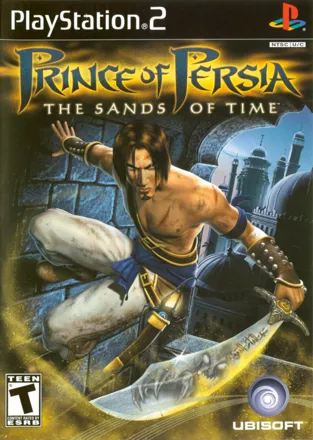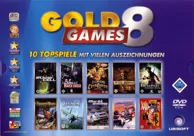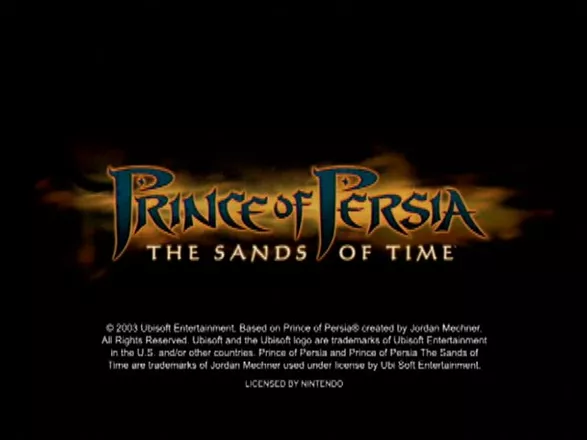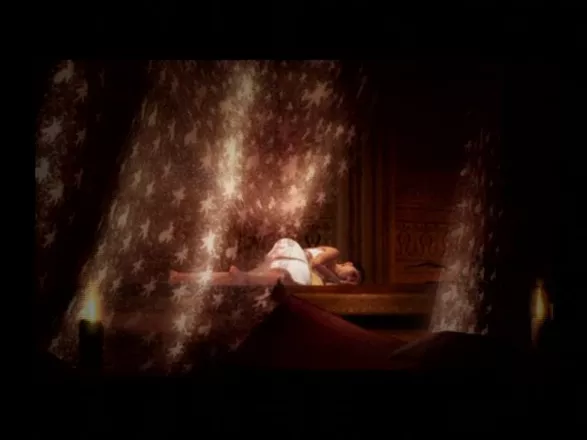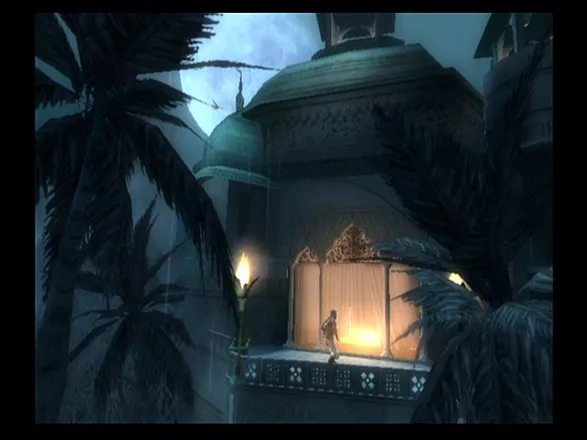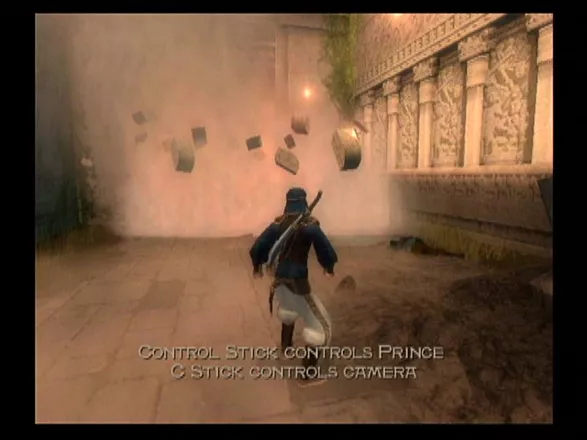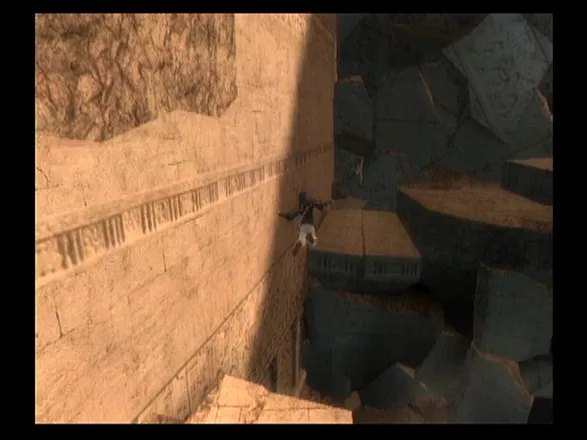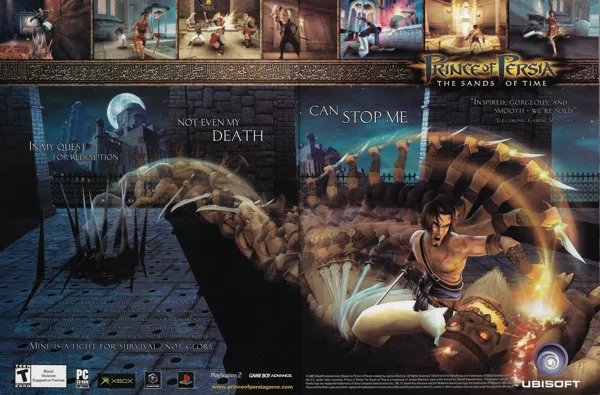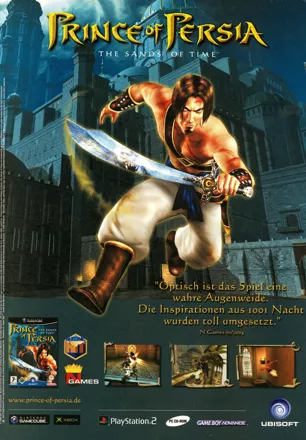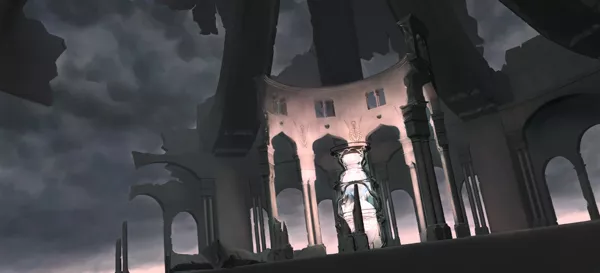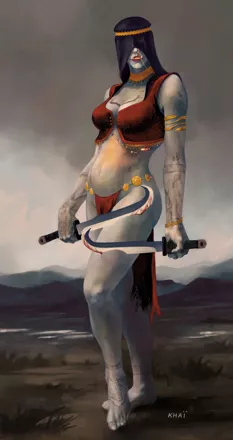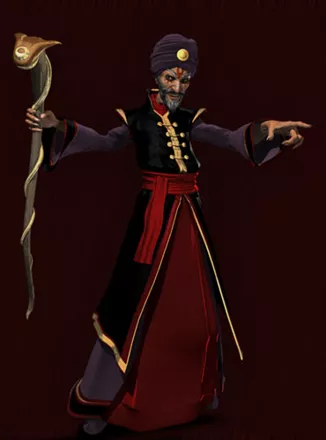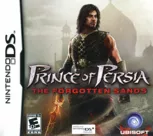Prince of Persia: The Sands of Time
-
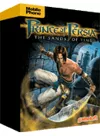 Prince of Persia: The Sands of Time
(2003 on
BREW,
J2ME,
Symbian)
Prince of Persia: The Sands of Time
(2003 on
BREW,
J2ME,
Symbian)
-
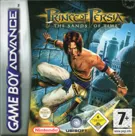 Prince of Persia: The Sands of Time
(2003 on
Game Boy Advance)
Prince of Persia: The Sands of Time
(2003 on
Game Boy Advance)
Description official descriptions
The King and the Prince of Persia are besieging the Maharajah's castle to plunder the treasures hidden inside. In order to impress his father, the Prince sneaks inside to recover the magical Dagger of Time. He quickly learns that this dagger has the ability to control time. The malevolent Vizier has other plans for the dagger, however, and tricks the Prince into unlocking a mysterious secret of the Dagger that causes the King and many of his subjects to be turned into sand zombies. Now, the Prince must figure out what has happened and try to set things right again.
Prince of Persia: The Sands of Time is an action game with platforming and puzzle-solving elements. It updates many of the gameplay concepts from the previous games, and brings them into a fully three-dimensional world. The Prince will engage in sword fighting, wall climbing, spike dodging, puzzle solving, and more in his quest. The Prince also carries the Dagger of Time, which allows him to unleash several magical powers. The most important of these powers is the ability to reverse time. This ability allows the player to reverse their actions when they lead the Prince to his death.
Spellings
- Принц Персии: Пески Времени - Russian spelling
- 波斯王子:时之砂 - Simplified Chinese spelling
- 波斯王子:遺忘之砂 - Traditional Chinese spelling
Groups +
- Covermount: Fullgames
- Covermount: Level (Romania)
- Game Engine: JADE
- Gameplay feature: Time manipulation
- Games made into movies
- Games with hidden / unlockable full games
- Green Pepper releases
- Middleware: Bink Video
- PlayStation 2 Greatest Hits releases
- PlayStation 2 Platinum Range releases
- Prince of Persia series
- Protagonist: Royalty
- Setting: Indian
- Software Pyramide releases
- Theme: Time travel
- Ubisoft eXclusive releases
- Xbox Platinum Hits releases
Screenshots
Promos
Videos
See any errors or missing info for this game?
You can submit a correction, contribute trivia, add to a game group, add a related site or alternate title.
Credits (PlayStation 2 version)
250 People (223 developers, 27 thanks) · View all
| Producer | |
| Creative Director | |
| Lead Programmer |
|
| Lead Level Designer |
|
| Art Director | |
| Animation Art Director | |
| Art Production Manager | |
| Animation Production Manager | |
| Sound Designer | |
| Writer | |
| Game Designer | |
| Creative Consultant | |
| Associate Producer | |
| Level Design Team | |
| Programing Team |
|
| [ full credits ] | |
Reviews
Critics
Average score: 91% (based on 117 ratings)
Players
Average score: 4.0 out of 5 (based on 262 ratings with 10 reviews)
Is this finally a successful revitalization of an old series?
The Good
In Prince Of Persia: The Sands Of Time you play the prince who of coarse is the son of the king of Persia with a vizier helping them who has more intentions than clear by breaking in the Maharajah’s vault and unleashing the sands of time which turns all but The Prince, Farah the maharajah’s daughter and the vizier because they each have a special artifact that protects them The dagger of time, a Medallion, And a staff.
But the dagger doesn’t just protect the prince from the curse it also allows the prince to reverse time when he gets in a sticky situation and you will need it a lot it’s not so helpful in combat but in the platforming elements it is which sometimes it can be difficult to figure out exactly where you are supposed to go the game has a very storybook type feel having the prince narrate the story.
The Bad
One of the strange things that happens because he tells the story when you die you’ll say something like “No no, no that’s not how it happened” then how does it happen? As if in the middle of the story the listener blurted out “And then you died?”
The combat also isn't particularly good with a lack of moves and the fact you have to finish the enemies with the dagger of time and the only things you can do is a regular attack and what is called a vault in which you jump over the enemy and attack as you come down which later enemies can block which can lead to some frustrating moments but was fixed in Warrior Within but that’s for another review.
The Bottom Line
Overall if you liked the original or you are looking for a fun new action game pick this one up.
Xbox · by Classic Nigel (108) · 2006
The Good
As the sun arose, the Grand Vizier betrayed his Maharajah and signaled the forces of the King of Persia. They sprang upon the waking city which quickly fell before them and none was braver or bolder than the Persian Prince. Time and again, his blade found flesh, but his quest was not for blood but for glory. The Maharajah's Treasure Room was yet to be found, but the Prince would find its location and disarm its traps, bringing the Dagger of Time back to his father. Then, on the road home, laden with slaves, plunder, and an enchanted hourglass, the Persian Army stopped at a friendly Caliph's Palace. Here the Dagger of Time and the Hourglass of Time would come into contact, the Sands of Time spilling forth and swallowing all life. All but the Prince— was he protected by the Dagger of Time? But wait, there's one of the slave girls and where is the Vizier?
Such is the premise of Prince of Persia: The Sands of Time, an action/adventure game set within the huge environments of the Palace and its grounds. With aid from Farah, the slave girl with noble bearing, the Prince must find a way to undo what was been done. For, as the Prince tells us, "Most people think time is like a river that flows swift and sure in one direction. But I have seen the face of time and I can tell you they are wrong. Time is an ocean in a storm."
The Prince faces two major obstacles in his quest: Sand Creatures and the Palace itself. The Sands of Time have made zombies of the Palace residents, from the Harem girls to the famed birds in the Caliph's aviary. The Prince can strike them down again and again, but there is no final death until the Prince uses the Dagger of Time to drain the Sands away from them. That isn't all the Dagger can do. As the Prince progresses in the game, the Dagger gains the power to bend Time—hasten or slow events, or rewind events up to ten seconds in the past.
As for the Palace, between the destructive nature of the Sands and the traps which have been enabled, it is a perilous place to visit. Luckily for the Prince, he has some fancy moves. In addition to running and jumping, he can run along a wall or run up a wall, swing from various bars and do all manners of flipping and tumbling. While all this should feel lifted from The Matrix or Hong Kong action movies, it seems more like a natural extension of the Prince's abilities from the 2D games. Although, in those games, if the Prince fell to his death, it was game over; in this one you can rewind (or reload). Also unlike those games, the path is not always clear. Much of the fun of this game (probably eighty percent of it) is looking around the huge environments and figuring out what must be done. Is there a button that can be pressed by running along a wall? Can you leap from a broken column to a rope? Is that chasm narrow enough to leap from side to side down? There is some help in the form of visions the Prince has when he encounters Sand Portals (which also serve as Save Points) these visions show what may, or may not, come to pass.
The other twenty percent is action. Prince of Persia has the most fluid, articulated combat I've seen. Collision detection is top notch—I've inched away from enemy blades and narrowly deflected blows. Apart from just pressing the attack button, there are many advanced attacks the Prince will have to use to defeat his enemies: flipping over them and attacking them from behind, launching his self off walls, and more. More challenging, there are some enemies immune to special attacks, they'll throw you down if you try to leap over them or knock you aside.
Prince of Persia has an excellent story narrated by the Prince which allows for great payoffs like him saying, "No no, that didn't happen," if he dies or promising to pick up the story from save points. There is more character development than I expected from an action platformer, chiefly related to the relationship between the Prince and Farah, but also in growth of the Prince's character.
Graphics are breathtaking, offering huge environments with stunning detail. Prison cells have graffiti, heat from torches creates a shimmering effect, and this game passes the beautiful waterfall test. The character models move believably and have a Disneyesque level of detail—actually the game kind of feels like Aladdin and Jasmine versus the Army of Darkness. Sound is also incredible. Voice work, music, and ambient effects are all tremendous. Every element combines to create an immersive gaming experience, making this a modern classic.
The Bad
My one major complaint about Prince of Persia: The Sands of Time has to do with combat. I mentioned above that creatures only die when drained by the Dagger of Time, but there are often many waves of creatures. And the Prince is always outnumbered, even with Farah's assistance (using her Bow of Friendly Fire—don't ask). So combat is slick, stylish, smooth, etc… and goes on for way too long. With the exception of a few boss battles, combat in this game only serves to lengthen game play.
Which is my second complaint. Or observation. You can beat this game in a weekend. And other than spotting a few secret areas, there aren't branching paths or multiple endings which add a replay value. Not that you wouldn't want to re-experience this masterpiece, but as DarkDove mentions, it's even shorter the second time around.
The Bottom Line
I'm still amazed at the tremendous amount of thought that went into this game. If you pay attention, you can spot how Farah is able to make her way through the Palace when she isn't with the Prince. There are incredible puzzles equal to any in a traditional adventure game. And you have to love how carvings actually add to the story, rather than act as wallpaper. All that and off-hand references to obscure Persian heroes!
PlayStation 2 · by Terrence Bosky (5395) · 2004
Such a great game crippled by such a simple flaw
The Good
Once again you take on the role of the Prince of Persia, but instead of forging though foreboding dungeons as then the original classics, he begins the story as a young warrior that's ready to prove himself in battle with a single goal in mind, to win glory by raiding the treasure vault. Risking death traversing the decaying ruins he only finds an odd dagger, but blinded by pride he claims his prize. However, the purpose of the dagger remains unknown to the naive Prince till the Vizier tricks him into unlocking the hourglass vessel that entraps the Sands of Time, turning all within the palace into zombies under its control save three souls, the Prince, the fallen Maharajah's daughter Farah, and the Vizier. Now the Prince must find a way to undo what has been done and somehow the dagger is the key.
The passages through the palace are blocked with fallen walls, puzzling diabolical traps and hoards of sand creatures. While this task may seem daunting to ordinary men, the Prince's blazing speed and agility allow him to not only leap and swing among the ruins, but run across the walls along deep chasms, climb up walls to unreachable ledges and levers, or even leap back and forth between them up to death defying heights. (As a word of warning, he can't climb walls very well when his feet are wet. Once he's out of the water give his feet a moment to dry.) His range of acrobatic skills are crucial to beating the puzzling paths created fallen ruins and clockwork traps set to kill all who pass. Many of the locked doors will begin to close as soon as they open, so he has to be quick and cunning to dodge the spinning and swinging spikes and blades in time. All of this may seem to be to much for one man, but by mastering a few simple actions the Prince can apply the needed move given the situation and direction he's traveling.
Luckily Farah, the one of the few real characters he meets, decides to aid him in his journey to the recover the hourglass, but only after saving her life. Soon the Prince realizes that her intelligence and petite figure are invaluable to beating many of the puzzles. However, the secrets she hides leads to distrust as well.
Traps are not the only thing that test the Prince. The former inhabitants of the palace have be transformed by the sands into creatures of the undead, forced to do its biding. Luckily the Prince can quickly block and attack in any direction and even leap over to into his attackers. Some of the sand creature may seem single minded, but the undead warriors are also swift and can block many of he moves. Even tough their attacks are usually predictable they can rematerialize anywhere at any time, so he must be cautious or they can easily entrap him. Luckily, Farah will ad you in many of the battles with her lightning fast bow, and mysteriously endless supply of arrows. However, since she doesn't carry a sword and her arrows are too weak to take down some the larger brutes, she can easily be overwhelmed in the later battles, so be careful since he cannot complete the journey to the tower alone.
Even with all of their their might and cunning, they cannot defeat the undead without releasing the sands from their deformed bodies. Soon the Prince learns that the dagger can also be used to weld the Sands of Time to his command, by reversing the flow of time to undo a recent mistake, to slow time to slip though a tough situation, or to release the sands from his foes. Most importantly the dagger can be used to retrieve the sand that is released, which is required for it to preform its time bending magic.
Unfortunately, the sand creatures often guard the sand vortex, the place where the Prince can return if he were to fail at any point, so if he cannot complete the journey to the next vortex he must return to the previous one. Fortunately, if he doesn't gave up, he can often return to a closer point. Since the other points are not typically marked, it can be hard to know where they will be.
Behind the magic of the story and the gameplay, the graphics overall are stunning. The level of detail of the characters and world isn't the greatest, but they strike a fare balance and are well done. While most action games that allow jumping and climbing ledges require a simplified world geometry, and Sands of Time (SoT) still maintains a fairly complex and nearly continuous world. While there are a good number of moving objects in the world, most of it however is static, many of the objects are simple doors and traps.
Atop all of this are detailed textures and soft lighting, which mostly make up for the simple underlying geometry. In fact the texturing of the models doesn't fall far behind those used in to scarce prerendered cutscenes. The world textures are also fairly detailed, but tend to be in monochromatic browns. However, when the world is mostly made of sand and sandstone, there really isn't much one can do. However the lighting does make up for some of the lack of color of the textures, especially in the indoor scenes such as the well. Also the shading and lighting used give it a nice soft somewhat cartoonish feel. After, this is no ultra realistic gore-fest like Doom 3. It's also in the little details where the game really shines. No, I mean literally. The Sands of Time really glow as they float like a soft fog over the floors of the rooms and halls and the dagger even glows in response whenever the Prince wonders near.
One of the elements that would have really ruined the game is animation, but SoT doesn't disappoint. The animation of the Prince is extremely fluid throughout all of the many moves he can preform. He smoothly follows through from one to another with out pausing and it seams that most actions can be interrupted if appropriate to do so. The animation of the other models doesn't fall far behind. One thing that seamed to be missing was facial animation during the game. The Prince's face doesn't seem to move at all when he speaks. At least the in game rendered cutscenes are better. Last, but not least the cloth animation was great. The wall banners fold, shift, and waft as the Prince touches against them or as he pushes them out of the way as runs along the wall behind them. Too bad that's about the only time you really get to see it in action.
The sound and voice overs in the game are great. The sounds are of good quality and the acting is simply top notch. The music in general was great, but I think that it would have been better with they didn't stray so much away from arabic motif with the electric guitar. I know they were going for a harder modern sound, but I would prefer that they didn't.
The Bad
First and for most, the one thing that completely ruined the game for me was the character control scheme. I've played a good number of PC adventure and action games and of the two kinds of control schemes commonly used, character and camera relative, the use of camera relative movement in SoT was by far one of the worst decisions I've seen in a long time. This isn't necessarily a bad thing for an action game, but SoT had to take it one step farther with dynamic camera movement. While sometimes being cinematographically eye catching, in others it becomes painfully clear why every other 3D 3rd person action game I've ever played almost always used character relative controls. I tried in vain to find any way to fix this simple mistake, but alas the option was nowhere to be found.
Most of the time you can at least control the camera to do whatever you wish, but often times it decides to reposition itself on it's own accord and occasionally refuses to move regardless of how bad the angle is. Typical case in point, the prince is on a ledge with the camera pointing let's say north and to the east you can see a pole and a hole in the facing wall the he has to swing to. Now the camera at this point might own its own either decide to swing around to the west so that you can't see the obstacles ahead or swing slightly to the west just enough at last moment so that instead of dashing across the wall toward the pole, continuing to push the right control button will send him climbing up the wall matrix style. Again when as soon as you make it up to the hole, camera swings around behind you to point east, showing you what lays beyond, but the shortly after you push the up button to run inside the camera will suddenly position itself on the other side pointing west. If you're not fast enough to stop or push down instead to account for the abrupt change in camera angle, the prince will spin around to match the new camera angle and run back out the hole again. Having to constantly readjust your prospective of how the controls move the prince through a hall when dodging traps is annoying, but having to do it constantly during battles is just ridiculous. A number of times when I tried to vault over a lesser sand creature to get out a sticky situation the camera would swing around enough that at the last moment that the up button when send the price vaulting over a staff man instead, which would in turn readily fling the prince to the ground with an overhead swing. Also in a few occasions the camera would get stuck with a section of wall or curtain between it and the prince such the view of the prince and his assailants was complete obscured.
My only other real complaint is about the save game points. I know that its a common, and antiquated, crutch commonly used in console games, yet it's a point that's often overlooked when porting games to the PC. At least they manged to integrate the logic of the save game point into the game better than most games I've played recently and even give you a bonus by showing you the path ahead.
The Bottom Line
I really wanted to like the game and often found this unique pole and sword swinging action/adventure to be a real blast, until I found myself caught between a battle with hoards of sand creatures and the constant disorientation induced by a runaway camera with a mind of it own. It's really sad to see a such a great game humbled by such a simple mistake.
Windows · by semicharm (8) · 2005
Discussion
| Subject | By | Date |
|---|---|---|
| Random slowdowns... | chirinea (47574) | Aug 13, 2008 |
| Which control is best for this? | chirinea (47574) | Feb 23, 2008 |
Trivia
1001 Video Games
Prince of Persia: The Sands of Time appears in the book 1001 Video Games You Must Play Before You Die by General Editor Tony Mott.
Advertising
The Internet marketing for Prince of Persia: The Sands of Time was Ubisoft's most successful campaign so far. Ad agency Digital Outlook targeted 15-24-year-old males with ads featuring characters from the game and its "acrobatic action gameplay". A DHTML overlay showing the Prince slicing through the computer screen with his sword had a click-through rate of 26.1%. A streaming video ad, showing the gameplay, had a click-through rate of 23.43%. These rates were 4x higher than the host site's average.
Armitt, Claire. Prince of Persia: the Sands of Time. (Case Study)" New Media Age. May 6, 2004 p30.
Cover
The PlayStation 2 Greatest Hits budget release of the game confusingly uses the cover art of the 2010 game Prince of Persia: The Forgotten Sands.
Farah
Curious about how Farah feels about the Prince? Use the free-look button to look at her during the game to see how their relationship grows.
Murals
On the opening level, just after the room in which you first see the sands of time / giant hourglass, you find a water-filled passage that has 6 murals on the walls. The contents of the murals seem to describe the legendary history of the sands of time:
- A blue god and winged goddess cradle the earth
- A red demon kills the blue god as he sleeps
- The red demon stalks the earth, eating humans
- The blue god returns from the dead and strikes down the red demon with lightning
- The blue god collects the sand from the red demon and pours it into an hourglass
- The blue demon grow four arms - 2 sport the hourglass - 2 carry a sword and the severed head of the red demon. Humans worship at his feet.
Hidden games
The PlayStation 2 and Gamecube versions feature a hidden version of the original Prince of Persia, which once unlocked can be played at will.
The Xbox version of the game features the first Prince of Persia, but also features a hidden Prince of Persia 2: The Shadow & The Flame, which will also show up as unlocked content.
The Windows version of the game does not feature either game hidden anywhere.
Rustam
Several times the main characters mention the "legendary" Rustam in comparison to what the Prince is able to do. Rustam was a Persian hero noted for his great strength. Born with prematurely gray hair, Rustam slew a rampaging white elephant with a single blow at the age of ten.
More at "Rustam." Encyclopedia Mythica. 2004. Encyclopedia Mythica Online.
Awards
- 4Players
- 2003 – Best Console Graphics of the Year (PlayStation 2)
- Computer Games Magazine
- March 2004 - #7 Game of the Year 2003
- Computer Gaming World
- March 2004 (Issue #236) – Action Game of the Year
- March 2004 (Issue #236) – Weapon of the Year (for the Dagger of Time)
- EGM
- February 2006 - #166 out of 200 of the "Greatest Games of Their Time"
- GameSpy
- 2003 – #10 Game of the Year (together with SoulCalibur II)
- 2003 – #4 Xbox Game of the Year
- 2003 – #9 GameCube Game of the Year
Information also contributed by Big John WV, PCGamer77, Rupert Breheny, Sciere and WildKard.
Analytics
Related Sites +
-
Prince-of-persia.com
Official website -
The Final Hours of Prince of Persia: The Sands of Time
Gamespot's extensive article about the production process of "Prince of Persia: The Sands of Time". -
Zarf's Mini-Review
A mini-review of the PlayStation 2 version of The Sands of Time by Andrew Plotkin (November, 2003).
Identifiers +
Contribute
Are you familiar with this game? Help document and preserve this entry in video game history! If your contribution is approved, you will earn points and be credited as a contributor.
Contributors to this Entry
Game added by quizzley7.
PlayStation 3 added by Charly2.0. PlayStation 2 added by Corn Popper. Xbox One, Xbox 360 added by Plok. Windows added by Cyberzed. Xbox added by JPaterson.
Additional contributors: MAT, Terrence Bosky, Unicorn Lynx, Apogee IV, JRK, Johnny "ThunderPeel2001" Walker, Sciere, Simone Curti, Zeppin, Eltahriel, Patrick Bregger, Plok, FatherJack, 一旁冷笑.
Game added November 30, 2003. Last modified February 11, 2025.


